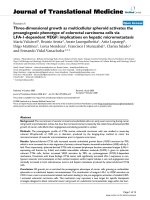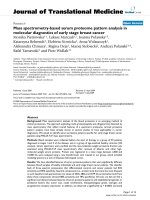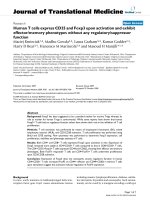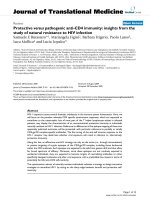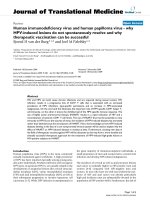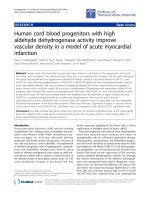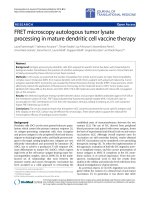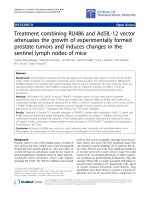báo cáo hóa học: " Human CNS cultures exposed to HIV-1 gp120 reproduce dendritic injuries of HIV-1-associated dementia Sam Iskander1, Kimberley A Walsh1 and Robert R " docx
Bạn đang xem bản rút gọn của tài liệu. Xem và tải ngay bản đầy đủ của tài liệu tại đây (913.43 KB, 9 trang )
BioMed Central
Page 1 of 9
(page number not for citation purposes)
Journal of Neuroinflammation
Open Access
Research
Human CNS cultures exposed to HIV-1 gp120 reproduce dendritic
injuries of HIV-1-associated dementia
Sam Iskander
1
, Kimberley A Walsh
1
and Robert R Hammond*
1,2
Address:
1
Department of Pathology, London Health Sciences Centre, University of Western Ontario, London, ON, Canada and
2
Department of
Clinical Neurological Sciences, London Health Sciences Centre, University of Western Ontario, London, ON, Canada
Email: Sam Iskander - ; Kimberley A Walsh - ;
Robert R Hammond* -
* Corresponding author
Abstract
HIV-1-associated dementia remains a common subacute to chronic central nervous system
degeneration in adult and pediatric HIV-1 infected populations. A number of viral and host factors
have been implicated including the HIV-1 120 kDa envelope glycoprotein (gp120). In human post-
mortem studies using confocal scanning laser microscopy for microtubule-associated protein 2 and
synaptophysin, neuronal dendritic pathology correlated with dementia. In the present study,
primary human CNS cultures exposed to HIV-1 gp120 at 4 weeks in vitro suffered gliosis and
dendritic damage analogous to that described in association with HIV-1-associated dementia.
Introduction
HIV-1-associated dementia (HAD) is a late, subacute to
chronic dementia characterized by a progressive and
severe decline in cognitive and motor function. HAD
remains a major debilitating consequence of HIV-1 infec-
tion. It is an independent risk factor for death from AIDS
and the most common form of dementia in young adults
worldwide [1-5]. Evidence of a reduction in the incidence
of HAD [6,7] and reports of cognitive improvement in
cases of mild dementia with highly active antiretroviral
therapy (HAART) have been presented [8]. Other studies
have failed to identify a lower incidence of HAD post-
HAART and a number of experts note the potential for a
changing tempo of HAD from a precipitous dementia to
one with a more protracted course and greater incidence
in patients with relatively preserved CD4 counts [3,4,8]. It
is premature to accurately predict how HAART will affect
the incidence of HAD in the long term. HAART clearly
does not afford complete protection and the potential for
an increase in the prevalence of HAD has been raised by
many [2,3,6,8-11].
HIV-1 associated neuronal damage has been characterized
with evidence for both cytocidal and subcytocidal inju-
ries. Evidence of loss of large neurons in the orbitofrontal,
temporal and parietal regions [12] has been demonstrated
in association with HAD. Other investigations have failed
to demonstrate a correlation between neuronal loss and
HAD [13].
Studies of HIV-1 associated neuronal damage using syn-
aptic and dendritic markers [14] have shed additional
light on the nature of the neuronal injury in HAD. Cases
with severe HAD suffered a 40% loss of dendritic area in
frontal cortex and a 40–60% loss of dendritic spine den-
sity in comparison with non-demented controls [12]. It
was suggested that disruption of post-synaptic elements,
characterized by sinuous, shortened, and vacuolated den-
drites may be the primary lesion leading to the reduction
in synaptic density and the development of dementia
[14]. These and subsequent studies suggested that
decreases in microtubule associated protein (MAP2) and
synaptophysin (SYN) immunoreactivity may be more
Published: 27 May 2004
Journal of Neuroinflammation 2004, 1:7
Received: 08 April 2004
Accepted: 27 May 2004
This article is available from: />© 2004 Iskander et al; licensee BioMed Central Ltd. This is an Open Access article: verbatim copying and redistribution of this article are permitted in all
media for any purpose, provided this notice is preserved along with the article's original URL.
Journal of Neuroinflammation 2004, 1 />Page 2 of 9
(page number not for citation purposes)
sensitive markers of neuronal injury [15] perhaps identi-
fying a more subtle primary injury.
The HIV-1 envelope glycoprotein gp120 has been linked
to the pathogenesis of HAD from several lines of evidence.
Both whole virus and gp120 alone have been shown to be
toxic to murine, avian and human CNS cultures [16,17].
Individual studies provided evidence that gp120 acts syn-
ergistically with NMDA receptor agonists [18]. HIV-1 neu-
rotoxicity was blocked in vitro by anti-gp120 antibodies
but not by anti-CD4 antibodies [17] indicating that its
toxicity was not dependent on CD4 receptor binding. Sev-
eral groups have demonstrated that neurotoxicity associ-
ated with gp120 exposure may involve chemokine
receptor activation [19-23] and may be further influenced
by Apolipoprotein-E genotype [24]. Hippocampal neu-
rons in mixed murine cultures are protected from gp120
by estrogenic steroids [25] while corticosterone exacer-
bates the gp120 inhibition of glutamate uptake [26].
Most evidence supports the theory that gp120 neuronal
toxicity is largely mediated through its interactions with
non-neuronal cells (microglia/monocytes and astrocytes)
as reviewed by Kaul et al. and Scorziello et al [3,27]. Acti-
vated microglia release compounds such as nitric oxide,
proinflammatory cytokines and glutamatergic excitotox-
ins, which can lead to neuronal membrane destablization
and [28-32]. In point of fact, conditioned media from
gp120-treated microglia was shown to be neurotoxic to
murine hippocampal cultures [33]. The ability of gp120
to cause the upregulation of inducible nitric oxide syn-
thase has been suggested in several studies [34,35] includ-
ing our own (Walsh et al.: Anhoxidant protection from
HIV-1 gp120-induced neuroglial toxicity. J Neuroinflamin
2004, 1:8). Furthermore, studies have shown that gp120
increases free radical generation, impairs antioxidant
defences and increases lipid peroxidation in cultures [36].
The alteration of cell cycle protein expression has recently
been shown to be associated with neuronal damage
caused by HIV [37].
The mechanism(s) of neuronal damage in this setting
remains controversial and there are few human models
available in which to study this human-specific disease.
Gliosis and neuronal dendritic injury have been well char-
acterized in association with HAD in post-mortem studies
and the present studies were undertaken to derive a
human culture system in which to study the pathogenesis
of these alterations. We report the findings of gliosis and
neuronal dendritic injury in primary mixed human CNS
cultures exposed to recombinant gp120. This provides an
additional tool for the study of HAD pathogenesis.
Materials and methods
Human primary CNS cultures
Human CNS tissue cultures were initiated from post-mor-
tem 16 to 18 week gestational age forebrain samples sub-
mitted to the Department of Pathology, London Health
Sciences Centre following institutional guidelines and
Research Ethics Board approval. The tissue was dissected
in fresh Dulbecco's Modified Eagle Medium, centrifuged
and resuspended in a serum-free and pyruvate-free
medium as previously described [38,39]. Suspension cul-
tures were initiated at a density of 5 × 10
6
cells/cm
3
in T-
75 flasks (resulting in free-floating neuroglial aggregates).
Monolayer cultures (for confocal microscope analysis)
were plated at a concentration of 1 × 10
6
cells/cm
3
onto
poly-ornithine (Sigma, Mississauga, ON, Canada) and
laminin (Gibco, Burlington, ON, Canada) coated glass
coverslips in 12 well plates. By preserving cells for imaging
in an intact state, monolayer preparations were optimal
for confocal immunofluorescent quantitative analysis of
changes in expression of structural proteins MAP2 and
glial fibrillary acidic protein (GFAP). All cultures were
incubated, humidified, at 37°C in 10% CO
2
and fed
biweekly by half media exchange. All experiments for
quantitative analyses by confocal microscopy were run in
duplicate from three separate primary cultures.
Gp120 exposure
At four weeks in vitro, cultures were exposed to 1 nM puri-
fied recombinant gp120
SF2
(Austral Biologicals, San
Ramon, CA) via half media exchange as previously
described [38]. Cultures were incubated with gp120 for 72
hours (or less, as in the case of the time series study of
apoptosis, necrosis and proliferation). This dose of gp120
was selected from a dose response experiment that
revealed no visible injury at levels below 1 nM and con-
siderable cellular injury and nuclear debris at levels above.
Hence 1 nM was used as the lowest dose with a measura-
ble effect at 72 hours (figure 1).
Immunofluorescence and confocal imaging
Immunofluorescence and confocal imaging followed pre-
viously published protocols [38,40]. Briefly, seventy-two
hours post-gp120 exposure, cultures were rinsed twice
with phosphate buffered saline (PBS) and fixed for 30
minutes with 4% paraformaldehyde. After two PBS rinses,
cultures were blocked with 5% horse serum with 0.1% Tri-
ton X100 for 1 hour and incubated with monoclonal
mouse anti-human MAP2 (Sigma, Mississauga, ON, Can-
ada, 1:500 dilution) and polyclonal rabbit anti-human
GFAP (Sigma, Mississauga, ON, Canada, 1:1000 dilution)
antibodies simultaneously for two hours at room temper-
ature. Paired monolayers were incubated with mouse
anti-human Class III beta tubulin (C3βT) (Sigma, Missis-
sauga, ON, Canada, 1:1000 dilution, recognizes neuron
specific microtubule protein) and polyclonal rabbit anti-
Journal of Neuroinflammation 2004, 1 />Page 3 of 9
(page number not for citation purposes)
human GFAP antibodies for two hours at room tempera-
ture. The cells were rinsed with PBS and incubated in the
dark with Texas Red conjugated goat anti-rabbit (Jackson
ImmunoResearch, West Grove, PA, 1:200 dilution) and
fluorescein isothiocyanate (FITC) conjugated goat anti-
mouse (Sigma, Mississauga, ON, Canada, 1:500 dilution)
for one hour at room temperature. The cells were rinsed
with PBS and incubated for 5 minutes with Hoechst
nuclear stain in PBS (Sigma, Mississauga, ON, Canada,
1:100 dilution). Following a final PBS wash, the monol-
ayers were mounted directly onto glass slides with Gelva-
tol fade resistant aqueous mounting media. Negative
controls were prepared in the absence of primary
antibody.
All cultures were imaged in a blinded fashion on a Zeiss
LSM 410 confocal microscope equipped with Krypton/
Argon and Helium/Neon lasers as previously described
[38]. Texas Red, FITC and Hoescht signals from twelve
random fields per coverslip were collected with a 63×
objective lens under oil immersion. Five serial vertical z-
planes were imaged within each field of view with a plane
thickness of 0.9 µm. Positive and negative controls were
run with all experimental sets and all related culture sets
were imaged in single sessions. Thresholds were set to
eliminate background fluorescence if present.
Cell counts were performed manually. Identification of
neurons and astrocytes was conservatively defined by cir-
cumnuclear expression of neuronal or astrocytic antigens
(MAP2 or GFAP) leading to a slight but consistent under-
estimate of both populations.
The intensity of immunofluorescent staining in each sam-
ple was measured, as determined by the average pixel
intensities for each fluorophore. Texas Red and FITC sig-
nals were normalized to the Hoechst signal.
Apoptosis, necrosis and cellular proliferation
Paired free floating neuroglial aggregate cultures were
fixed at 0, 2, 6, 12, 24 and 72 hours post-gp120 exposure.
The cultures were rinsed with PBS and fixed in 4% para-
formaldehyde for 30 minutes. The cells were then sus-
pended in 5% agar and embedded in paraffin blocks. 4
µm sections were cut from each sample and analysed for
apoptosis by terminal dUTP nick end labelling (TUNEL)
(Intergen, Purchase, NY). Positive nuclei were identified
by dark brown staining of shrunken or clumped nuclei.
Ten random fields from each section were viewed under a
40× objective and the percentage of apoptotic nuclei in
relation to total (methyl green counterstained) nuclei was
determined. Ki-67 (Vector, Burlington, ON, Canada) pos-
itive nuclei were enumerated relative to total nuclei in 10
random fields. Immediately prior to fixation the media
was sampled and assayed for lactate dehydrogenase
(LDH) according to manufacturer's directions (Sigma,
Mississauga, ON, Canada). Positive and negative controls
were run with all sets.
Statistical analysis
For quantification of MAP2 and GFAP staining in the
CSLM images, data were analyzed by Student's t-test. Data
obtained from assays of apoptosis, necrosis and cellular
proliferation were analyzed by one-way ANOVA followed
Seventy-two hour exposure to 1 nM gp120 causes observa-ble cellular injuryFigure 1
Seventy-two hour exposure to 1 nM gp120 causes
observable cellular injury. Representative photomicro-
graphs of control (a) and gp120 exposed (b) cultures. There
is nuclear pyknosis, neuropil vacuolation and fewer visible
cell processes in cultures exposed to gp120 for 72 hours.
H&E, all bars = 25 µm.
Journal of Neuroinflammation 2004, 1 />Page 4 of 9
(page number not for citation purposes)
by a Tukey's multiple comparison post-hoc test. In both
cases, probabilities of p < 0.05 were considered
significant.
Results
Routine light and confocal immunofluorescent micros-
copy of more than 20 separate primary cultures revealed
several consistent qualitative morphological changes in
neurons and astrocytes associated with a gp120 exposure
including nuclear pyknosis and a reduction in fine cellular
processes (figure 1). Neuronal processes in gp120-
exposed cultures were fewer, more sinuous, varicosed and
vacuolated compared to controls (figure 2a). Astrocytes
exposed to gp120 became more prominent in number
and size (figure 2b).
Quantitative analysis of confocal images revealed a 37%
decrease in MAP2 immunoreactivity (p < 0.05, Student's
t-test) and 43% increase in GFAP immunoreactivity (p <
0.02, Student's t-test) following gp120 exposure (figure
3). No significant differences were found in counts of total
or MAP2-associated nuclei between experimental and
control conditions. An 84% increase in the number of
GFAP-associated nuclei was observed after gp120 expo-
sure (p < 0.01, Student's t-test). No increase in total nuclei
and no significant proliferation (see below) suggested that
the increase in GFAP-associated nuclei was the result of
astrocytic hypertrophy and recruitment of immature glia.
There was no evidence of colocalization of MAP2 and
GFAP.
Apoptosis was not significantly increased in gp120-
exposed cultures at any time point compared with con-
trols within 24 hours of exposure (Tukey's). At 72 hours
post exposure there was a small increase in the incidence
of TUNEL-positive nuclei compared with all other time
points except for 2 hours. Proliferation as estimated by Ki-
67 immunohistochemistry (percentage of Ki-67 positive
nuclei) showed no significant difference between condi-
tions. Similarly, cellular necrosis, as assayed by LDH
release, was not significantly increased with gp120-expo-
sure (figure 4).
Discussion
HAD and the Minor Cognitive Motor Disorder (MCMD)
remain common, debilitating and costly complications of
HIV-1 infection and independent risk factors for death in
AIDS [1]. Recent post-mortem investigations of HAD
identified neuronal dendritic pathology as a correlate of
dementia [15,41]. Recent clinical evidence has suggested
that some cases of HAD show a degree of improvement on
HAART [6-8,42] and although apoptosis may occur in the
setting of HAD, the correlation between apoptosis and
dementia is poor [43]. Taken together, these findings and
the present report support the theory that the primary
Gp120 exposure results in astrocytic hypertrophy and a reduction in dendritic complexityFigure 2
Gp120 exposure results in astrocytic hypertrophy
and a reduction in dendritic complexity. Representa-
tive immunofluorescent images from 4-week monolayer con-
trol cultures (a) and cultures exposed to gp120 for 72 hours
(b) stained for C3βT (green) and GFAP (red). Neuronal
processes in the gp120 exposed condition appear reduced,
sinuous, varicosed and vacuolated in comparison to controls.
All bars = 20 µm.
Journal of Neuroinflammation 2004, 1 />Page 5 of 9
(page number not for citation purposes)
Quantitative analysis confirmed gp120 induced astrocytic hypertrophy and reduced dendritic complexityFigure 3
Quantitative analysis confirmed gp120 induced astrocytic hypertrophy and reduced dendritic complexity. Rep-
resentative immunofluorescent images from 4-week monolayer control cultures (a) and cultures exposed to gp120 for 72
hours (b) stained for MAP2 (green) and GFAP (red). All bars = 20 µm. Quantitative immunofluorescent analysis of the effect of
72 hour gp120 exposure on MAP2 and GFAP expression (normalized to nuclear staining) using confocal scanning laser micro-
scopic images is shown in (c). Bars represent normalized mean pixel intensities from 12 random fields +/- SEM. Gp120 treated
cultures demonstrate a 37% decrease in MAP2 immunoreactivity (p < 0.02) and a 43% increase in GFAP immunoreactivity (p <
0.01) in comparison with controls. Error bars: +/- 1 standard error.
Journal of Neuroinflammation 2004, 1 />Page 6 of 9
(page number not for citation purposes)
Gp120 exposure did not induce cell proliferation, necrosis or TUNEL within 24 hours of exposureFigure 4
Gp120 exposure did not induce cell proliferation, necrosis or TUNEL within 24 hours of exposure. Gp120 expo-
sure time series data for Ki-67 (a), LDH (b) showing no significant differences at timepoints between 0 and 72 hours for prolif-
eration or necrosis. TUNEL (c) data suggest a small increase in apoptosis over baseline at 72 hours after gp120 exposure in
comparison to all timepoints except 2 hours. Error bars: +/- 1 standard error.
a
b
c
0
1
2
3
4
5
6
7
8
9
026122472
Length of gp120 exposure (hours)
LDH activity (10
-6
U/L)
0
1
2
3
4
0 2 6 122472
Length of gp120 exposure (hours)
% TUNEL positive cells
0
0.5
1
1.5
2
2.5
3
0 2 6 122472
Length of gp120 exposure (hours)
% Ki-67 positive cells
Journal of Neuroinflammation 2004, 1 />Page 7 of 9
(page number not for citation purposes)
insult and reversible component of dementia, may be one
of neuronal dysfunction and subtle dendritic injury with
cumulative injuries leading to more extensive dendritic
damage, cell death and an irreversible component of
dementia. Further studies are needed to examine the asso-
ciation between dendritic injury, neuronal loss and the
reversibility of dementia. Apart from post-mortem studies
of human brain, there is a limited opportunity to study
the pathogenesis of HAD in human cells. The system
described herein represents such a tool.
In the present study we have identified a qualitative and
quantitative injury to the dendritic arbour of gp120
exposed neurons. The density of processes was reduced
and remaining processes showed pathological structural
alterations (fragmentation, varicosities, etc.). Further-
more, the changes in dendritic architecture were accompa-
nied by a significant decrease in the volume and intensity
of MAP2 immunoreactivity. Gp120 exposed cultures also
demonstrated astrocytic hypertrophy and an increase in
total GFAP immunoreactivity. These findings are reminis-
cent of those described in HAD in vivo [15,41] and provide
further evidence that gp120 is a contributing factor in
human neuronal injury.
TUNEL data suggest a small increase in apoptosis over
baseline at 72 hours after gp120 exposure in comparison
to all timepoints except 2 hours. Subsequent studies
(Walsh et al. Anhoxidant protection from HIV-1 gp 120-
induced neurogical toxicity. J. Neuroinflam
2004, 1:8)
suggest that this cytocidal injury is preceded by morpho-
logic alteration to astrocytes and neurons. Many other
authors have also shown an apoptotic component of
gp120 toxicity in a variety of experimental systems
[12,16,18,44]. The apparent sequence of cytotoxic, and
presumably reversible, injury (GFAP and MAP2 altera-
tion) followed by cytocidal, and presumably irreversible,
injury (TUNEL) invites a comparison to HAD whereby
HAART has been shown to provide some cognitive
improvement (reversible component) but with some
residual symptomatology (irreversible component) [8].
Ki-67 data suggest no significant change in DNA replica-
tion in response to gp120 exposure. Likewise, LDH analy-
ses show no evidence of increased necrosis. In the absence
of significant nuclear turnover, an increase in the number
of astrocytes in gp120 exposed cultures suggests the possi-
ble recruitment of existing precursors to form new astro-
cytes as a component of the observed increase in GFAP-
positive cells.
Conclusions
This culture system [38] offers certain advantages to the
study of neurotoxicity associated with HIV-1 being
derived from human tissue (of relevance in studying the
effects of a human-specific virus) grown under conditions
that promote the maturation of neurons in the absence of
astrocytic overgrowth. It has been adapted to studies of
engraftment [40] and oxidative injury [45] and the
present report documents its ability to reproduce neu-
ropathological correlates of HAD, providing an additional
tool for the study of dendritic injury in this form of
dementia. The present study characterizes cytotoxic and
cytocidal injuries associated with gp120 exposure in
human primary mixed CNS cultures.
Abbreviations used
C3βT; Class III beta tubulin
CSLM; confocal scanning laser microscopy
FITC; fluorescein isothiocyanate
GFAP; glial fibrillary acidic protein
gp120; HIV-1 120 kDa envelope glycoprotein
HAART; highly active antiretroviral therapy
HAD; HIV-1 Associated Dementia (HAD)
HIV-1; Human Immunodeficiency Virus I
LDH; Lactate dehydrogenase
MAP2; microtubule-associated protein 2
MCMD; Minor Cognitive Motor Disorder
PBS; phosphate buffered saline
SYN; synaptophysin
TUNEL; terminal dUTP nick end labelling
Competing interests
None declared.
Authors' contributions
RH conceived of the study. RH, SI and KW designed and
carried out the experiments and collected and analyzed
the data in the laboratory of RH. RH, SI and KW co-wrote
the manuscript. All authors read and approved the final
manuscript.
Acknowledgements
The authors wish to thank Monique LeBlanc, Margaret MacSween, Jane
Nassif and Laurel Hammond for technical assistance. We are also indebted
to Dr. Clayton Wiley, Dr. Cris Achim and Dr. Kem Rogers for their advice
and critiques. This work was supported by a grant to RH from the Ontario
HIV Treatment Network (OHTN).
Journal of Neuroinflammation 2004, 1 />Page 8 of 9
(page number not for citation purposes)
References
1. Ellis RJ, Deutsch R, Heaton RK, Marcotte TD, McCutchan JA, Nelson
JA, Abramson I, Thal LJ, Atkinson JH, Wallace MR, Grant I: Neuro-
cognitive impairment is an independent risk factor for death
in HIV infection. San Diego HIV Neurobehavioral Research
Center Group. Arch Neurol 1997, 54:416-424.
2. Clifford DB: Human immunodeficiency virus-associated
dementia. Arch Neurol 2000, 57:321-324.
3. Kaul M, Garden GA, Lipton SA: Pathways to neuronal injury and
apoptosis in HIV-associated dementia. Nature 2001,
410:988-994.
4. Sacktor N, McDermott MP, Marder K, Schifitto G, Selnes OA,
McArthur JC, Stern Y, Albert S, Palumbo D, Kieburtz K, De Marcaida
JA, Cohen B, Epstein L: HIV-associated cognitive impairment
before and after the advent of combination therapy. J
Neurovirol 2002, 8:136-142.
5. McArthur JC, Hoover DR, Bacellar H, Miller EN, Cohen BA, Becker
JT, Graham NM, McArthur JH, Selnes OA, Jacobson LP: Dementia
in AIDS patients: incidence and risk factors. Multicenter
AIDS Cohort Study. Neurology 1993, 43:2245-2252.
6. Dore GJ, Correll PK, Li Y, Kaldor JM, Cooper DA, Brew BJ: Changes
to AIDS dementia complex in the era of highly active
antiretroviral therapy. AIDS 1999, 13:1249-1253.
7. Ferrando S, van Gorp W, McElhiney M, Goggin K, Sewell M, Rabkin J:
Highly active antiretroviral treatment in HIV infection: ben-
efits for neuropsychological function. AIDS 1998, 12:F65-F70.
8. Sacktor NC, Lyles RH, Skolasky RL, Anderson DE, McArthur JC,
McFarlane G, Selnes OA, Becker JT, Cohen B, Wesch J, Miller EN:
Combination antiretroviral therapy improves psychomotor
speed performance in HIV-seropositive homosexual men.
Multicenter AIDS Cohort Study (MACS). Neurology 1999,
52:1640-1647.
9. Major EO, Rausch D, Marra C, Clifford D: HIV-associated
dementia. Science 2000, 288:440-442.
10. Lipton SA: Treating AIDS dementia. Science 1997,
276:1629-1630.
11. Walsh K, Thompson W, Megyesi J, Wiley CA, Hammond R: HIV-/
AIDS Neuropathology in a canadian teaching centre. Can J
Neurol Sci 2003, in press:.
12. Masliah E, Ge N, Achim CL, Hansen LA, Wiley CA: Selective neu-
ronal vulnerability in HIV encephalitis. J Neuropathol Exp Neurol
1992, 51:585-593.
13. Everall IP, Glass JD, McArthur J, Spargo E, Lantos P: Neuronal den-
sity in the superior frontal and temporal gyri does not corre-
late with the degree of human immunodeficiency virus-
associated dementia. Acta Neuropathol (Berl) 1994, 88:538-544.
14. Masliah E, Achim CL, Ge N, DeTeresa R, Terry RD, Wiley CA: Spec-
trum of human immunodeficiency virus-associated neocorti-
cal damage. Ann Neurol 1992, 32:321-329.
15. Everall IP, Heaton RK, Marcotte TD, Ellis RJ, McCutchan JA, Atkinson
JH, Grant I, Mallory M, Masliah E: Cortical synaptic density is
reduced in mild to moderate human immunodeficiency virus
neurocognitive disorder. HNRC Group. HIV Neurobehavio-
ral Research Center. Brain Pathol 1999, 9:209-217.
16. Dreyer EB, Kaiser PK, Offermann JT, Lipton SA: HIV-1 coat pro-
tein neurotoxicity prevented by calcium channel
antagonists. Science 1990, 248:364-367.
17. Kaiser PK, Offermann JT, Lipton SA: Neuronal injury due to HIV-
1 envelope protein is blocked by anti-gp120 antibodies but
not by anti-CD4 antibodies. Neurology 1990, 40:1757-1761.
18. Lipton SA, Sucher NJ, Kaiser PK, Dreyer EB: Synergistic effects of
HIV coat protein and NMDA receptor-mediated
neurotoxicity. Neuron 1991, 7:111-118.
19. Catani MV, Corasaniti MT, Navarra M, Nistico G, Finazzi-Agro A,
Melino G: gp120 induces cell death in human neuroblastoma
cells through the CXCR4 and CCR5 chemokine receptors. J
Neurochem 2000, 74:2373-2379.
20. Kaul M, Lipton SA: Chemokines and activated macrophages in
HIV gp120-induced neuronal apoptosis. Proc Natl Acad Sci U S A
1999, 96:8212-8216.
21. Pandey V, Bolsover SR: Immediate and neurotoxic effects of
HIV protein gp120 act through CXCR4 receptor. Biochem Bio-
phys Res Commun 2000, 274:212-215.
22. Catani MV, Corasaniti MT, Ranalli M, Amantea D, Litovchick A, Lapi-
dot A, Melino G: The Tat antagonist neomycin B hexa-arginine
conjugate inhibits gp-120-induced death of human neurob-
lastoma cells. J Neurochem 2003, 84:1237-1245.
23. Nath A, Haughey NJ, Jones M, Anderson C, Bell JE, Geiger JD: Syn-
ergistic neurotoxicity by human immunodeficiency virus
proteins Tat and gp120: protection by memantine. Ann Neurol
2000, 47:186-194.
24. Corder EH, Robertson K, Lannfelt L, Bogdanovic N, Eggertsen G,
Wilkins J, Hall C: HIV-infected subjects with the E4 allele for
APOE have excess dementia and peripheral neuropathy. Nat
Med 1998, 4:1182-1184.
25. Zemlyak I, Brooke SM, Sapolsky RM: Protection against gp120-
induced neurotoxicity by an array of estrogenic steroids.
Brain Res 2002, 958:272-276.
26. Brooke SM, Sapolsky RM: Effects of glucocorticoids in the
gp120-induced inhibition of glutamate uptake in hippocam-
pal cultures. Brain Res 2003, 972:137-141.
27. Scorziello A, Florio T, Bajetto A, Schettini G: Intracellular signal-
ling mediating HIV-1 gp120 neurotoxicity. Cell Signal 1998,
10:75-84.
28. Bruce-Keller AJ: Microglial-neuronal interactions in synaptic
damage and recovery. J Neurosci Res 1999, 58:191-201.
29. Giulian D, Vaca K, Noonan CA: Secretion of neurotoxins by
mononuclear phagocytes infected with HIV-1. Science 1990,
250:1593-1596.
30. Giulian D, Wendt E, Vaca K, Noonan CA: The envelope glycopro-
tein of human immunodeficiency virus type 1 stimulates
release of neurotoxins from monocytes. Proc Natl Acad Sci U S
A 1993, 90:2769-2773.
31. Chao CC, Hu S, Molitor TW, Shaskan EG, Peterson PK: Activated
microglia mediate neuronal cell injury via a nitric oxide
mechanism. J Immunol 1992, 149:2736-2741.
32. Boje KM, Arora PK: Microglial-produced nitric oxide and reac-
tive nitrogen oxides mediate neuronal cell death. Brain Res
1992, 587:250-256.
33. Brooke SM, Sapolsky RM: Glucocorticoid exacerbation of gp120
neurotoxicity: role of microglia. Exp Neurol 2002, 177:151-158.
34. Dugas N, Lacroix C, Kilchherr E, Delfraissy JF, Tardieu M: Role of
CD23 in astrocytes inflammatory reaction during HIV-1
related encephalitis. 2001, 15:96-107.
35. Pozzoli G, Tringali G, Dello Russo C., Vairano M, Preziosi P, Navarra
P: HIV-1 Gp120 protein modulates corticotropin releasing
factor synthesis and release via the stimulation of its mRNA
from the rat hypothalamus in vitro: involvement of inducible
nitric oxide synthase. J Neuroimmunol 2001, 118:268-276.
36. Howard SA, Nakayama AY, Brooke SM, Sapolsky RM: Glucocorti-
coid modulation of gp120-induced effects on calcium-
dependent degenerative events in primary hippocampal and
cortical cultures. Exp Neurol 1999, 158:164-170.
37. Brandimarti R, Khan MZ, Fatatis A, Meucci O: Regulation of cell
cycle proteins by chemokine receptors: A novel pathway in
human immunodeficiency virus neuropathogenesis? J
Neurovirol 2004, 10(Suppl 1):108-112.
38. Hammond RR, Iskander S, Achim CL, Hearn S, Nassif J, Wiley CA: A
reliable primary human CNS culture protocol for morpho-
logical studies of dendritic and synaptic elements. J Neurosci
Methods 2002, 118:189-198.
39. Martin FC, Wiley CA: A serum-free, pyruvate-free medium
that supports neonatal neural/glial cultures. J Neurosci Res
1995, 41:246-258.
40. White MG, Hammond RR, Sanders VJ, Bonaroti EA, Mehta AP, Wang
G, Wiley CA, Achim CL: Neuron-enriched second trimester
human cultures: growth factor response and in vivo graft
survival. Cell Transplant 1999, 8:59-73.
41. Masliah E, Heaton RK, Marcotte TD, Ellis RJ, Wiley CA, Mallory M,
Achim CL, McCutchan JA, Nelson JA, Atkinson JH, Grant I: Den-
dritic injury is a pathological substrate for human immuno-
deficiency virus-related cognitive disorders. HNRC Group.
The HIV Neurobehavioral Research Center. Ann Neurol 1997,
42:963-972.
42. McArthur JC, Sacktor N, Selnes O: Human immunodeficiency
virus-associated dementia. Semin Neurol 1999, 19:129-150.
43. Adle-Biassette H, Chretien F, Wingertsmann L, Hery C, Ereau T,
Scaravilli F, Tardieu M, Gray F: Neuronal apoptosis does not cor-
relate with dementia in HIV infection but is related to micro-
glial activation and axonal damage. Neuropathol Appl Neurobiol
1999, 25:123-133.
Publish with Bio Med Central and every
scientist can read your work free of charge
"BioMed Central will be the most significant development for
disseminating the results of biomedical research in our lifetime."
Sir Paul Nurse, Cancer Research UK
Your research papers will be:
available free of charge to the entire biomedical community
peer reviewed and published immediately upon acceptance
cited in PubMed and archived on PubMed Central
yours — you keep the copyright
Submit your manuscript here:
/>BioMedcentral
Journal of Neuroinflammation 2004, 1 />Page 9 of 9
(page number not for citation purposes)
44. Dawson VL, Dawson TM, Uhl GR, Snyder SH: Human immunode-
ficiency virus type 1 coat protein neurotoxicity mediated by
nitric oxide in primary cortical cultures. Proc Natl Acad Sci U S A
1993, 90:3256-3259.
45. Cai L, Cherian MG, Iskander S, Leblanc M, Hammond RR: Metal-
lothionein induction in human CNS in vitro: neuroprotec-
tion from ionizing radiation. Int J Radiat Biol 2000, 76:1009-1017.
